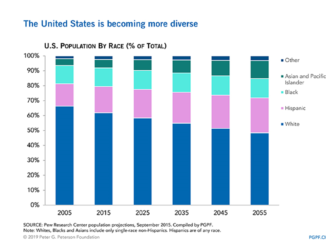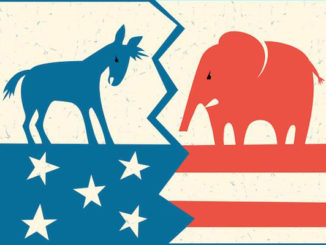
John Judis and I came up with the idea of an emerging Democratic majority. A dangerous misinterpretation of it helped elect Donald Trump.
by Ruy Teixeira
The idea that demographic changes are sure to favor Democrats has done tremendous damage to the party’s electoral prospects over the past decade. In this important longread, Ruy Teixeira, the thinker who is most closely associated with this conventional wisdom, explains why it is based on a dangerous misunderstanding of both the facts and his own theory. I hope you’ll take the time to read it. Yascha
In the months after Barack Obama’s historic victory, the conventional wisdom held that Democrats would now dominate the nation’s politics for decades. “There have been long periods where one party generally has the upper hand,” famous Democratic strategist James Carville remarked at the time. Obama’s victory, the title of Carville’s new book predicted, marked the beginning of just such an epoch: 40 More Years—How Democrats Will Rule the Next Generation.
Carville’s analysis was based on a simple narrative: Groups that favor Democrats are growing. Groups that favor Republicans are shrinking. Demographic change will keep swelling the Democratic ranks until Republicans have little choice but to surrender.
It is a narrative I know well, for it is based on a bowdlerization of my own work. In 2002, John Judis and I published The Emerging Democratic Majority. In our book, we argue that Democrats should take advantage of a set of interrelated social, economic and demographic changes, including the growth of minority communities and cultural shifts among college graduates.
But we also emphasized that building this majority would require a very broad coalition, including many voters drawn from the white working class. This crucial nuance was quickly lost. And so, many Democratic pundits, operatives and elected officials have falsely come to believe that demographics are destiny.
The result has been a decade-long electoral disaster. With the exception of Obama’s victory in 2012, Democrats lost just about every important election for the next eight years. By early 2016, the party was down to 44 seats in the United States Senate, 188 seats in the House of Representatives, 18 governorships and 3,164 seats in state legislatures—the fewest elected offices Democrats have held nationwide since the 1920s. Then came the coup de grace: Donald Trump defeated Hillary Clinton to become the 45th President of the United States.
If Democrats don’t correct their misunderstanding of what it takes for them to win elections, the next decade could turn out to be just as bitter as the last. But even after ten painful years, their most influential operatives continue to believe that demographic changes will inevitably give them a decisive advantage. So it is time for me to set the record straight.
The Real Nature of the Obama Coalition
Demographic changes really do favor Democrats—to an extent.
As John Judis and I wrote in 2002, the number of voters from racial minorities is rapidly growing. The share of American voters who are black, Hispanic, Asian or belong to another minority racial group goes up by about two percentage points every four years. And all of these groups really do prefer Democrats to Republicans by a significant margin.
Democrats can also seize upon other long-term changes. Women are becoming more liberal, and this tendency is especially pronounced among those segments of the female vote that are growing especially quickly: the unmarried and the highly educated. This is part of a broader trend towards the Democratic Party among the growing professional class, with its permissive social values and support for active government.
All these trends, we argued, were coming together in dynamic metropolitan areas rooted in the emerging postindustrial economy. These “ideopolises”—places like the Raleigh-Durham Research Triangle and the suburbs of Washington D.C.—were realigning and putting states formally dominated by Republicans, like North Carolina and Virginia, into play for the Democrats.
In the first years after the book was published, reality seemed to conspire against our thesis. Republicans performed strongly in the 2002 midterms and George W. Bush comfortably won a second term in 2004. But then the political winds began to change. As Bush’s popularity plummeted, and Democrats began to recover a lot of lost ground in the 2006 midterm elections, the idea of the emerging Democratic majority seemed to describe the coalition the junior senator from Illinois was trying to put together in his unlikely run for the White House.
From the beginning, Obama’s coalition was dominated by the groups we identified in our book. According to sophisticated synthetic estimates by the big data firm Catalist, Obama carried black voters by 90 points, Hispanics by 27 points, Asians and those of other races by 26 points. He also won young voters by 29 points, unmarried women by 22 points, college graduates by 7 points and suburban voters by 5 points, with strong turnout across the board. The trends we had described were especially pronounced in key states he moved into the Democratic column: Colorado and Nevada in the Southwest; Virginia, North Carolina and Florida in the South.
After Obama’s historic victory, our theory morphed from provocative projection to sacred gospel. Instead of focusing on the fact that this emerging majority only gave Democrats tremendous potential if they played their cards right, many progressives started to interpret it as a description of an inevitable future. The new Democratic majority, they believed, had already arrived. All they had to do to win election after election was to mobilize the growing segments of the electorate, and the demographic changes that favored them would take care of the rest. Sometimes explicitly, sometimes implicitly, our thesis turned into the simplistic argument that “demographics are destiny.”
But our argument had been much more complicated than that. We had always envisaged the new Democratic majority as a coalition between growing segments of the population and the party’s traditional electorate. To be sure, this coalition would include a lot of the voters progressives now chose to focus on: minorities, professionals and the young, and unmarried and highly educated women. But in addition to this “rising American electorate,” it would also have to include a significant minority of the white working class, a group that—though its numbers were in decline—would continue to constitute a very large electoral block for the foreseeable future. (In 2008, 51 percent of eligible voters belonged to the white working class; in the 2020 elections, 44 percent will.)
To hold this broad coalition together, we argued, Democrats needed to adopt a form of “progressive centrism.” The party should proudly emphasize the ability of government to improve the lives of ordinary Americans. But its governing ideology could not present itself as standing in radical opposition to the country’s founding values:
[Americans] want government to play an active and responsible role in American life, guaranteeing a reasonable level of economic security to Americans rather than leaving them at the mercy of the market and the business cycle. They want to preserve and strengthen Social Security and Medicare, rather than privatize them. They want to modernize and upgrade public education, not abandon it. They want to exploit new bio-technologies and computer technologies in order to improve the quality of life. They do not want science held hostage to a religious or ideological agenda. And they want the social gains of the sixties consolidated, not rolled back; the wounds of race healed, not inflamed.
Obama seemed to understand all of this. He vowed to bring the country together and fulfill its promise. He pledged to take quick action to repair damage caused by the Great Recession and fix the broken financial system, and he stressed economic fairness. The most important legislative initiative of his first year in office was a move toward universal health care.
Because of his determination to appeal to all sections of the American electorate, Obama not only excelled at mobilizing the vote among growing segments of the population: he also significantly improved Democrats’ performance among white working-class voters. According to Catalist, Obama only lost this group of voters by 10 points nationwide in 2008, a much narrower margin than John Kerry had achieved four years earlier.
But the real nature of Obama’s coalition was quickly forgotten in the celebratory mood following the election of America’s first black President. Over the following years, Democrats came to believe that demographic changes were saving them from the need to appeal to voters beyond the ranks of their most supportive groups.
As future elections revealed, that was a huge mistake. The conviction that demographics are destiny subverted the hard thinking necessary to keep a broad coalition together in the face of the economic damage wrought by the Great Recession and the intense partisan warfare unleashed by the GOP. With the Tea Party movement infusing the right with new energy, and many working-class whites turning against Obama because of worsened economic conditions, the limits of the emerging Democratic majority were quickly revealed. As the President famously put it on the night of a bitter defeat in the 2010 midterms, he took a bad “shellacking” at the polls.
The 2010 elections should have provided a serious warning about how vulnerable the Democratic coalition was to backlash from white non-college voters. Sensing this, Obama crafted a reelection strategy that was focused on shoring up his broad coalition. He retained the fervent support of the “rising American electorate” by defending immigrants and “Dreamers,” stressing his support for the rights of women and gay people, and highlighting his actions against climate change. But he was also careful to appeal to white working-class voters in the Rust Belt states by touting his rescue of the auto industry and portraying Mitt Romney as a rich hedge funder who didn’t care about their well-being.
Obama was reelected—but his deficit among white non-college voters doubled. This deficit, while still low enough to enable Obama’s re-election, should have set off alarm bells in progressive circles. The coalition Obama had built was starting to fracture and the future success of the party depended on cobbling it back together.
Instead, progressives drew the opposite conclusion.
Democrats Double Down on Their Mistake
After 2012, two interlocking developments led to the full embrace of the idea that demographics are destiny.
First, the bowdlerization of the emerging Democratic majority thesis neatly complemented the political predilections of a rising set of people who placed questions of group identity and disadvantage at the heart of their political activism. This approach, which soon came to be known as “identity politics,” privileges mobilization around multiple, intersecting levels of oppression based on group identification over mobilization around universal rights and principles that bind people together across groups. Since most white non-college voters were rightly perceived to be uninterested in—if not outright hostile to—the core tenets of intersectional politics, those who favored this approach had a reason to embrace an electoral strategy that dispensed with them.
Second, the Republican Party was captured by right-wing populism. As its leading politicians began to play on racial and xenophobic fears in an increasingly overt manner, large parts of the left decided that anybody who was at all attracted to this hateful brand of politics could not possibly return to the Democratic tent: the best course of action was simply to ignore such voters.
The rise of Donald Trump understandably turbocharged this tendency. Surely, the conventional wisdom went, the emerging Democratic majority doesn’t need voters who can stomach Trump’s bigotry (even if they had voted for America’s first black president twice over). The apotheosis of this attitude was Hillary Clinton’s infamous statement that half of Trump’s supporters belonged in a “basket of deplorables”—the kind of gaffe that reveals what its speaker really thinks.
The result was Clinton’s shocking and tragic defeat in the 2016 election. Her campaign took a high-stakes bet on the rising American electorate—and lost. Her margin of victory among African-Americans, Latinos, young voters and highly educated women, while significant, was notably lower than that Obama had enjoyed in 2012. Turnout among these groups was markedly worse. But the fatal blow to her presidential ambitions was delivered by the massive shift of white non-college voters toward Trump in the critical states of Michigan, Pennsylvania and Wisconsin. Nationally, the Democrats’ white non-college deficit ballooned to 28 points: nearly three times Obama’s deficit in 2008.
As Democrats sorted through the wreckage of the election, the demographics as destiny strategy did not receive the burial it deserved. Instead, progressive activists focused exclusively on Clinton’s lackluster support from young and non-white voters, and argued that she had been paying too much attention to the white working class. As Sally Kohn wrote at the Daily Beast, “the Democratic Party’s fixation on white working-class voters … isn’t just fraught with bias. It’s also dumb.” In the New York Times, Steve Phillips essentially called upon Democrats to give up on the white working class: “The country is under conservative assault because Democrats mistakenly sought support from conservative white working-class voters susceptible to racially charged appeals. Replicating that strategy would be another catastrophic blunder.”
Most of these activists and analysts quickly converged on a different theory: Mobilizing the base, to them, was not a necessary part of the game; it was its be-all and end-all.
The theory of politics as base mobilization was adopted by a large majority of the candidates competing in the 2020 Democratic primary. In the attempt to appeal to their base, candidates endorsed a raft of proposals that are unpopular among a clear majority of Americans, including the elimination of private health insurance, the abolition of the Immigration and Customs Enforcement Agency, the decriminalization of the Mexican border, and the extension of the vote to all prisoners. As core advisors to Bernie Sanders, the candidate who could sell this platform in the most authentic manner, made clear over and over again, the idea was not just to win the primaries by mobilizing the rising American electorate: it was to beat Trump in the general election by generating a “tsunami of turnout” among young and non-white voters.
But despite Sanders’ early successes in Iowa and New Hampshire—states whose electorates are, ironically, dominated by older whites—his momentum came to a screeching halt in the South Carolina primary. Black Democrats, who tend to be more moderate than their white counterparts, overwhelmingly voted for the least woke and radical candidate left in the field: Joe Biden. And so the candidate who had nary a supporter in the press, and had already been written off by many pundits, proceeded to run the table on Super Tuesday. His success was owed to strong support from a broad coalition of voters—including African-Americans, women, suburban moderates, whites with a college education and, yes, rural voters and whites without a college education. Even within the rising American electorate, the appetite for far-left policies was far less strong than the vast majority of Biden’s opponents had come to believe.
Biden Is Putting the Obama Coalition Back Together
How is Biden likely to fare in the general election?
Unlike Obama, Biden is not himself a representative of the rising American electorate. But, perhaps counterintuitively, he could prove an excellent steward of the emerging Democratic majority.
Like Obama, Biden instinctively grasps that building a Democratic majority requires cobbling together a very broad coalition. Like Obama, Biden seeks to be president of the American people as a whole. And like Obama, he very much welcomes white non-college voters into the progressive coalition. Far from writing off all those who voted for Trump in 2016 as irredeemable racists, he recognizes that a huge number of them now feel dismayed and betrayed.
This stance is as evident in Biden’s proposed policies as in his persona. Along with the rest of the Democratic party—and the country as a whole—Biden has moved to the left. The policies he has announced so far are considerably more progressive than those of any previous Democratic candidate. He has pledged to expand Medicare, to create a public health insurance option, to make a massive investment in infrastructure, and to move towards zero carbon emissions. But though they are certainly bold, these policies remain squarely within the ambit of what Judis and I termed “progressive centrism.” Biden has not shied away from rejecting those parts of progressive orthodoxy—like the elimination of private health insurance and the decriminalization of the southern border—that are broadly unpopular.
It is this progressive centrism that has allowed Biden to steer safely through the tumultuous seas of the past months. He has strongly supported the protest movement over the murder of George Floyd, and quickly proposed a slew of serious reforms of policing practices. But at the same time, he swiftly decried the violence associated with some of the protests and declined to sanction the highly unpopular call to “defund the police.” While he has endorsed taking down Confederate statues, he insisted that statues of iconic American figures like George Washington and Thomas Jefferson must be protected.
The fundamental facts of American politics have not, then, changed all that much over the past two decades. Demographic and economic changes are favoring Democrats. But to capitalize on these changes, Democrats need to hew close to the center of public opinion and retain the votes of a significant portion of the white working class.
This is no easy task. But even in the age of Donald Trump, it can be accomplished. Indeed, it is this kind of strategy that delivered huge gains to Democrats in the 2018 midterms, when moderate insurgents hammered Republican incumbents by promising better health care, decrying tax cuts for the rich, and pledging their commitment to economic fairness. And if current polls are to be believed, it is also the reason why Biden has now taken a commanding lead over Donald Trump: As his support among young and non-white voters has firmed up, he is making big gains among white college voters, has halved Clinton’s deficit among white non-college voters, and is shifting millions of seniors to the Democratic column.
The election is still five months away. But now, more than at any point in the past four years, there is reason to believe that Joe Biden may succeed in restoring the soul of America—by reuniting the broad demographic coalition that so many Democrats have been tempted to abandon.
Ruy Teixeira is a Senior Fellow at the Center for American Progress and the co-author, with John Judis, of The Emerging Democratic Majority. His most recent book is The Optimistic Leftist: Why the 21st Century Will Be Better Than You Think.



